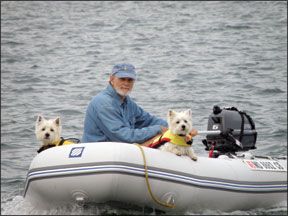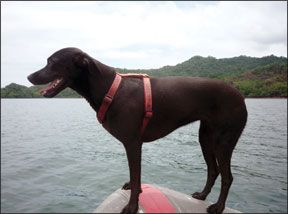On strolling through Port Townsend (Wash.) Boat Haven, while I was having some work done on my boat, I saw this boat (photo at right) and the owners attitude written on a sign in front of the boat. It reminded me of your June 18, 2013 blog, Dont Let Refit Pitfalls Derail Your Cruising Plans.
Photos courtesy of Rick Fricchione

Mike Hirko Destiny,
Tayana Vancouver 42 Gig
Harbor, Wash.
I read with interest PSs recent comments regarding mold/mildew solutions (PS, June 2013), and I have a recommendation for you to consider. The product is Mold Armor Mold and Mildew Stain Remover from W.M. Barr in Memphis, Tenn. I have used it on hard surfaces and fabric where it successfully removed the staining on both surfaces, and it did not bleach the fabric. This is the best mold remover and inhibitor I have come across, and I have a long list of less successful products.
Dick Diforio,
Via email
We previously tested Mold Armors predecessor, Klean Strip, naming it our Best Choice in the January 2009 test of mold and mildew removers and reporting that it was our top pick for extreme cases in the June 2010 evaluation of mildew preventers. Klean Strip, which was discontinued and replaced with Mold Armor (www.moldarmor.com), had a higher bleach content than Mold Armor, making Mold Armor a better choice for use on fabrics and fiberglass.
As an owner of a Standard Horizon HX300, I read the July 2013 review of handheld VHFs carefully. First, the text stated this radio floats face up, but the Value Guide stated it floats face down. I was reluctant to toss it into the water and see for myself which was correct, so please check your test results. Secondly, upon contacting Standard Horizon to obtain a charger for the HX300, I was told that it was a discontinued model. The radio performs very well, and the accompanying users manual was easy to read and quite complete.
Dr. Charles F. Barth,
Crazy Horse, C&C 37 TR
Lorain, Ohio
The Value Guide accompanying the July article on VHF handhelds gave incorrect information; it should have stated that the HX300 handheld floats face up. The online version of the table has been updated. According to Standard Horizon Vice President Jason Kennedy, the HX300 is indeed a current model (as of presstime), and parts and accessories are readily available from Standard Horizon.
In the June 24 Inside Practical Sailor blog, we asked readers what breed of dog is best suited as a cruising companion, and so many of you responded that we wanted to share the comments and snapshots of canine crew hard at work. For more on sailing pooches, check out our Facebook page.
Chow-chows and schnauzers: We have had two dogs with us for years while cruising: a miniature schnauzer and a chow-chow. They both have acclimated to the boat quite well. Outside of the dogs looking at you with yellow eyes at 6 a.m. on a rainy morning when you would rather stay below, its been lots of fun sailing with companions like this.
Photos courtesy of Rick Fricchione

A few thoughts: 1. While we like big, cuddly dogs, they don’t necessarily make it easy on you sailing. You need lots of food, big bowls of water, and lots of space for them to lie around. They also need to be hoisted up the companionway. Consider this as you get older. 2. We cannot say enough positive things about the mini schnauzer. They are smart dogs (18 to 20 pounds) with great personalities, and like to cuddle and be with you. They are not too big to carry up the companionway, nor are they too big to drag out of the water if they go in. Ours is smart enough to know what we mean by tacking and moves from one side to the other like a well-drilled crew member. (Our chow knew this too, but the size aspect offsets. Thats a lot of cockpit taken up when you want some room with lines or other people.) 3. Life jackets are a must, even if you have a swimmer for a dog. Keeping afloat in choppy water or when their fur gets waterlogged is tough.
Rick and Bonnie Fricchione,
Black Diamond, Hylas 49
Portsmouth, R.I.
Laurie Jones

Pitbull: We cruise with our pitbull, Kemah. Hes been great! He has his own section on our blog, So Many Beaches, www.somanybeaches.com, where his cruising adventures are recounted and youll find our tips on living aboard with a dog.
Laurie and Damon Jones
Mother Jones, Gemini 3400
Austin, Texas
Terriers: Our previous dog was a 10-pound Maltese, who sailed with us for about 12 years. She was too small for our Sabre 34; she had to be helped from just about any surface to another. But she was not shy about using the bow to do her business. When our Maltese passed on, we looked for another cruising companion. We thought something a little larger would be better-a dog able to make his or her way around the boat but still small enough to lift in and out of a dinghy and to be comfortable in the limited space aboard. We thought 40 pounds of doggage was about right, but that it would be easier to handle in two modules.
We ended up with a pair of West Highland terriers at about 20 pounds each. They enjoy swimming and sailing, and really enjoy dinghy rides to shore. Unfortunately, they hate to do their business on the boat. When we do 24-hour overnight coastal hops, they generally hold it until we get them back to shore.
and Al Robber

Al Robbert,
Sabre 34
Via email
Golfito Black Dog: On my birthday in January 2010, I was presented with a bundle of wiggles from off the Costa Rican ports beach. I named Ana for her presenter. Ana is the first of a truly distinct breed. Born without a tail, black and noisy, she may have some schipperke, but she has ears like a lab, weighs but 30 pounds, and is highly intelligent and perversely active, requiring fetch games constantly. She sounds like a guard dog as someone approaches, but promptly turns on her back, expecting tummy rubs from everyone. She does a pretty good job of keeping porpoises off the deck and frigates off the rigging; boobies ignore her. She is the first one into the dinghy, and would prefer to go ashore several times a day, but is content with one trip, if shore is in site, and sleeps well if it is not. Her noise and energy make her less than a perfect boat dog considered from afar, but our relationship and her excellent communication skills make her the most important thing on the boat.
Bill Nokes,
Someday, GS 41
Chetco Cove, Ore.
I was interested in your article on dehumidifiers (PS, June 2013). Living in South Florida means that excess humidity is a problem nine or 10 months of the year. My boat is in the water year-round. The water temperature varies from 70 to 82 degrees, and the air temperature from 50 to 95 degrees. In the summer, the cabin temperature can frequently top 105 degrees.
At one time, I used the standard household dehumidifier sitting on the sink of my boat, and plumbed it to allow the condensate to drip straight into the sink drain. (Without this precaution, the dehumidifiers reservoir would over flow in less than two days.) The biggest drawback to the dehumidifier was that it increased the temperature inside the boat even more. Trying to then cool down the boat before going for a sail was almost impossible and caused me to abandon this approach to the problem.
I am very interested to know whether the Peltier-type dehumidifier would do the same. Perhaps during the summer months of your test, you could take some readings to estimate the temperature rise.
Some of the other boats near me use a 5000- or 8000-BTU window air-conditioner as a way of dehumidifying their cabins. The A/C unit is simply set into the hatchway with a modified hatch board to form a good seal between boat and unit. This approach certainly keeps the boat interior cool and dry. The big drawback is removing the A/C and passing from the boat to someone on the dock. I am hoping the Peltier dehumidifier will be a reasonable alternative.
Raymond Tollman,
Clicquot, Pearson 38
Palm Beach, Fla.








































